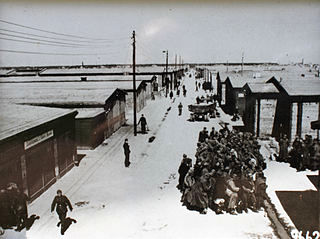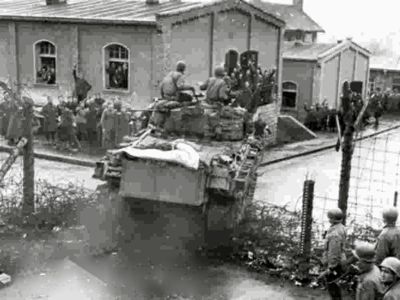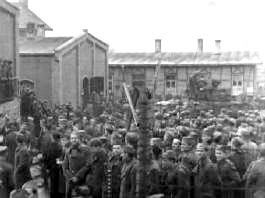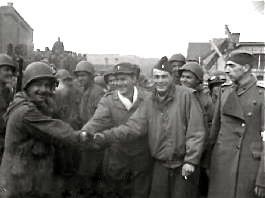MASSIVE ESCAPE OF GERMAN POWs
Bridgend, South Wales · March 10, 1945
Twenty-two miles west of the Welch capital, Cardiff, was a British prisoner-of-war camp built to house mainly German but also some Italian prisoners. Capable of accommodating 2,000 inmates, the camp was called Island Farm. On this date in 1945, 67 POWs (one source says as many as 84 POWs) escaped from Island Farm through a 70‑ft‑long tunnel that breached the camp perimeter. The breakout was the largest escape attempt from any European POW camp. (The largest escape took place in 1944 in Cowra, New South Wales, Australia, at a Japanese POW camp, when at least 545 prisoners attempted an escape.)
Some of the techniques used by the fugitives in Wales were ingenious and not too dissimilar from those depicted in the film and book of the same name, The Great Escape, which focused on the March 24–25, 1944, escape of 76 British airmen (out of 200 who tried) from “escape-proof” Stalag Luft III in what is now Żagań, Western Poland, but then part of German Lower Silesia. To dig the Welch tunnel camp inmates used cans and knives from the mess hall; soil was hauled out in a makeshift box and put into knapsacks. The tunnel roof was held up by wood retrieved from benches and beds. A hand-cranked fan forced air through a ventilation pipe made from condensed milk cans. The men were divided into groups and each had identity papers forged in the camp. They also had rough sketches of Welch railroads and roadways. When the POWs made their escape late on March 10, one set used a stolen car to reach Birmingham in the English West Midlands, 120 miles away. Another set reached Southampton, the major port on the south coast of England. The fugitives were eventually captured; none was officially punished, unlike the 50 recaptured British airmen from Stalag Luft III whom Adolf Hitler ordered executed.
The nearest equivalent to a mass breakout in the U.S. was attempted by 25 German detainees at Papago Park east of Phoenix, Arizona. After crawling through a 178‑ft tunnel just before Christmas 1944, they headed for the nearby Salt River, their intended escape route to Mexico, 150 miles to the south. The fugitives, some carrying wooden boards to fashion into a raft, were hugely disappointed to find that the Salt River was a dry riverbed, even in the dead of winter. By January 28, 1945, the last fugitive had been captured.
![]()
[amazon_carousel widget_type=”ASINList” width=”600″ height=”200″ title=”Recommended Reading” market_place=”US” shuffle_products=”False” show_border=”False” asin=”0425252736,0812885619,1591145260,0393325792,1585445452,1416505318,0465091237,1572337281,0755310381,0786424044″ /]
Scenes of Three Stalags (Prisoner-of-War Camps) in Germany
 |  |
Left: Stalag, a contraction of “Stammlager” (“Main Camp”), was a German term used for prisoner-of-war camps, of which there were 54. (By contrast, the U.S. had 511 POW camps.) Stalag IV‑B (shown here), about 30 miles north of Dresden, was one of the largest POW camps in Germany. At the end of December 1944, some 7,500 Americans arrived, prisoners taken in the Battle of the Bulge. When the Soviet Army arrived at Stalag IV‑B on April 23, 1945, there were roughly 30,000 POWs crowded into the facilities. About 3,000 of them died, mainly from tuberculosis and typhus.
![]()
Right: An M4 Sherman tank of Gen. George S. Patton’s 14th Armored Division crashes into the prison compound at Oflag XIII‑B, an officers POW camp (“Offizier-lager”) two miles south of Hammelburg, Bavaria, on April 6, 1945. A raid sanctioned by Patton, whose son-in-law was a prisoner at the camp, failed 11 days earlier. All of the 57 tanks, jeeps, and other vehicles were lost in that first raid. Of the roughly 300 men in the March raiding party (Task Force Baum), 32 were killed and only 35 made it back to Allied-controlled territory, with the rest taken prisoner.
 |  |
Left: Just after the liberation of Stalag XIII-C. The American television sitcom Hogan’s Heroes, which aired from 1965 to 1971, was situated in a fictitious POW camp called “Stalag 13” said to be near Hammelburg. There was no resemblance between the fictional camp and the actual Stalags XIII‑A, -B, and -C other than name and location.
![]()
Right: Freed POWs at Stalag XIII‑C. Following Germany’s surrender, the northern part of the Stalag XIII was used to intern former Nazi Party members. The camp also housed large numbers of German refugees who had fled the advancing Red Army in Eastern Germany as well as ethnic Germans who had been expelled from areas of Poland and Czechoslovakia.
Various Scenes of Allied POWs Following Liberation; Germans Entering Captivity; Gen. Eisenhower Touring Ohrdruf, a Subcamp of Buchenwald Death Camp
![]()

 History buffs, there is good news! The Daily Chronicles of World War II is now available as an ebook for $4.99 on Amazon.com. Containing a year’s worth of dated entries from this website, the ebook brings the story of this tumultuous era to life in a compelling, authoritative, and succinct manner. Featuring inventive navigation aids, the ebook enables readers to instantly move forward or backward by month and date to different dated entries. Simple and elegant! Click
History buffs, there is good news! The Daily Chronicles of World War II is now available as an ebook for $4.99 on Amazon.com. Containing a year’s worth of dated entries from this website, the ebook brings the story of this tumultuous era to life in a compelling, authoritative, and succinct manner. Featuring inventive navigation aids, the ebook enables readers to instantly move forward or backward by month and date to different dated entries. Simple and elegant! Click 











